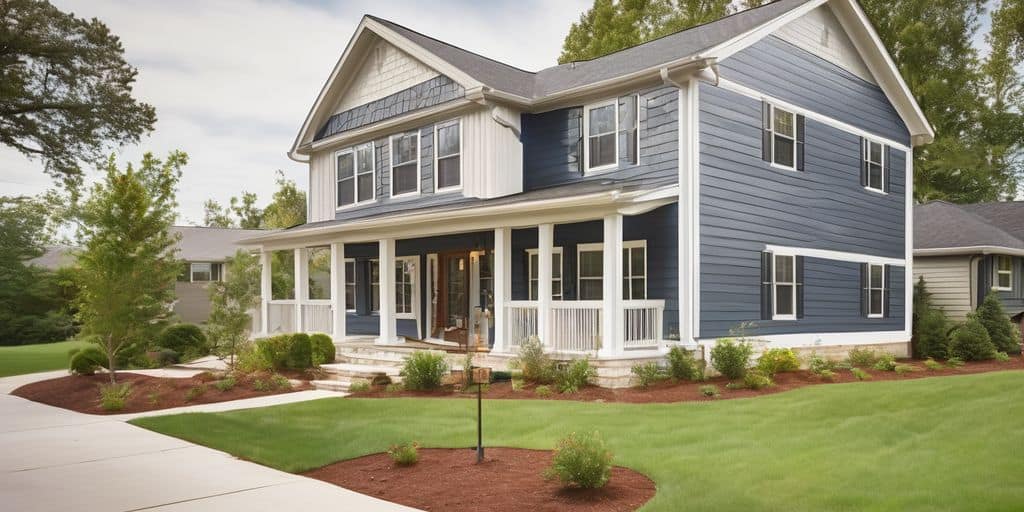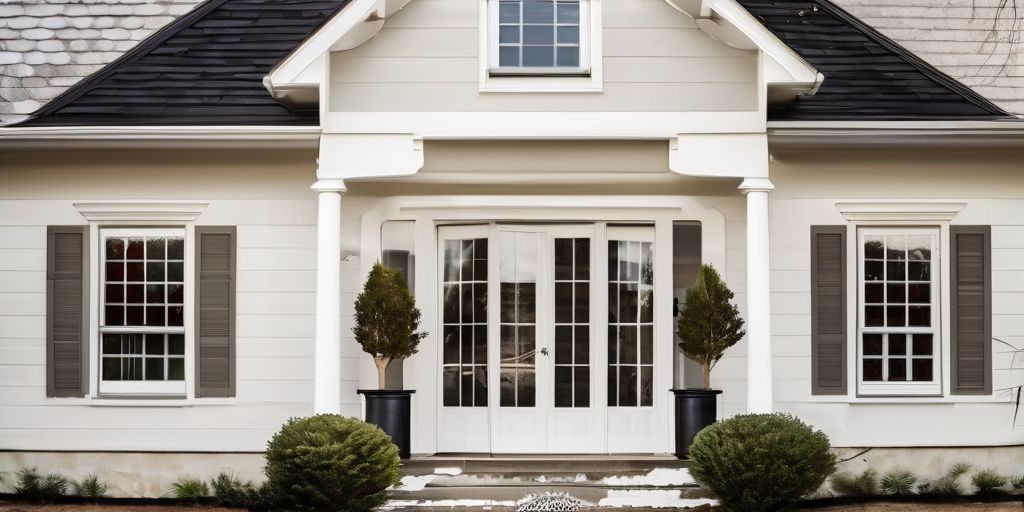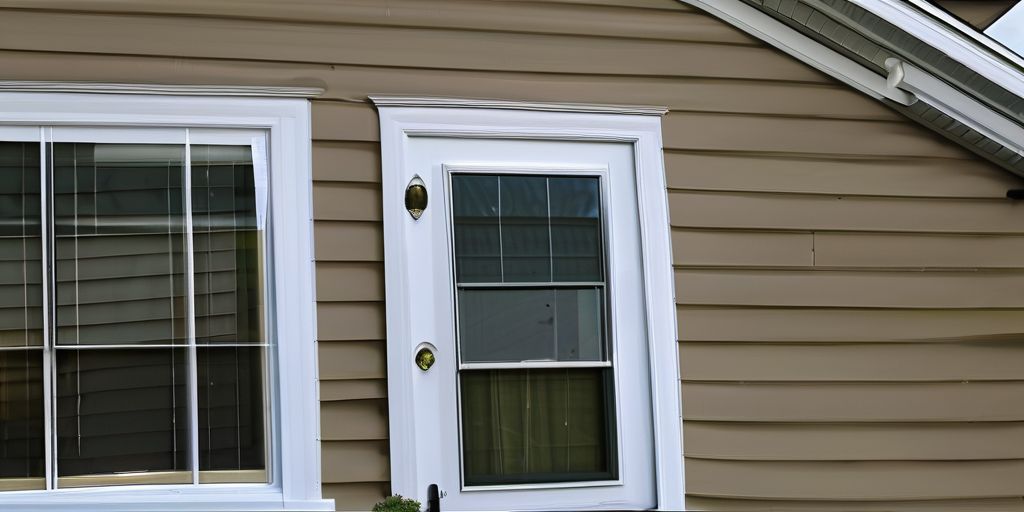This article is going to explore the pros and cons of vinyl siding painting, covering the most important decision factors, some commonly asked questions, and more. As proud homeowners, we do everything we can to keep our property as aesthetically pleasing as possible. Unfortunately, our vinyl siding will fade after years of exposure to the elements. At this point, we’re faced with a situation: do we replace the siding or should we paint it?
Key Takeaways
- Painting vinyl siding is a cost-effective way to refresh your home’s exterior without the expense of replacing the siding entirely.
- High-quality paint can extend the lifespan of your vinyl siding and improve your home’s curb appeal.
- There are potential drawbacks, such as voiding the manufacturer’s warranty and requiring frequent maintenance.
- Choosing the right paint and color is crucial to avoid issues like heat absorption, which can cause buckling or warping.
- Hiring professional painters can still be cheaper than replacing siding and ensures a higher quality finish.
Benefits of Painting Vinyl Siding
Painting vinyl siding offers several advantages that can make it an appealing option for homeowners looking to refresh their home’s exterior. Here are some key benefits:
Cost-Effective Solution
Painting your vinyl siding is a cost-effective way to give your home a fresh look without the expense of replacing the siding entirely. This approach can save you a significant amount of money while still achieving a renewed appearance.
Enhanced Curb Appeal
A fresh coat of paint can dramatically enhance your home’s curb appeal. You can choose from a wide range of colors to customize the look of your home, making it stand out in the neighborhood. This not only makes your home more attractive but can also increase its value.
Extended Siding Lifespan
By painting your vinyl siding, you can extend its lifespan by protecting it from UV damage, pests, and other harmful elements. High-quality paint acts as a barrier, helping to maintain the siding’s integrity and appearance for years to come.
Painting your vinyl siding is an environmentally friendly option, as it reduces the amount of waste that ends up in landfills by extending the life of your existing siding.
Drawbacks of Painting Vinyl Siding
Potential Warranty Issues
One of the significant drawbacks of painting vinyl siding is the risk of voiding your manufacturer’s warranty. Many manufacturers have specific guidelines and restrictions regarding painting, and not adhering to these can result in losing warranty coverage. This can be a considerable downside if your siding is still under warranty and you encounter issues later on.
Color Limitations
When it comes to painting vinyl siding, there are notable color limitations. You can only use paint colors with a Light Reflective Value (LRV) of 55 or above. Darker colors can absorb more heat, leading to warping or damage to the siding. This restriction can limit your color choices and may not align with your desired aesthetic.
Frequent Maintenance
Painting vinyl siding is not a permanent solution. Over time, the paint may chip, peel, or fade, requiring additional maintenance and repainting. Typically, you’ll need to repaint every 5 years to maintain the appearance and protection of your siding. This ongoing maintenance can be time-consuming and costly.
While painting vinyl siding can extend its life and improve its appearance, it’s essential to weigh these drawbacks before making a decision.
Comparing Painting to Replacing Vinyl Siding
When deciding between painting and replacing vinyl siding, there are several factors to consider. Each option has its own set of benefits and drawbacks, and the best choice depends on your specific needs and circumstances.
Cost Comparison
One of the most significant factors is cost. Painting vinyl siding is generally more cost-effective than replacing it. Here’s a quick comparison:
| Option | Average Cost per Square Foot |
|---|---|
| Painting | $1.25 – $3.00 |
| Replacing | $5.00 – $10.00 |
Painting can save you a substantial amount of money upfront, making it an attractive option for budget-conscious homeowners.
Time and Labor
Painting vinyl siding is usually quicker and requires less labor compared to a full replacement. A painting project can often be completed in a few days, whereas replacing siding can take a week or more. This means less disruption to your daily life and a faster turnaround time.
Long-Term Results
While painting is a cost-effective and quick solution, it may not offer the same long-term benefits as replacing your siding. New vinyl siding can last for decades with minimal maintenance, whereas painted siding may require touch-ups and repaints every 5-10 years. If you’re looking for a long-term, low-maintenance solution, replacing might be the better option.
For those considering eco-friendly options, painting can be a more environmentally friendly alternative to replacement. It reduces waste and allows you to refresh your home’s appearance without the need for new materials.
Choosing the Right Paint for Vinyl Siding
When painting vinyl siding, selecting the right paint is crucial. Here are some factors to consider when choosing the best vinyl siding paint for your project:
Color Selection Tips
Choosing the right color is essential. Too dark of a color can cause the lighter siding underneath to warp. It is generally recommended to use a siding color that is similar or lighter than the color of your current siding. Some major paint companies offer a curated palette of colors that they consider to be safe for vinyl siding.
Quality of Paint
Look for high-quality 100% acrylic paint for vinyl siding. Acrylic paint adheres well to vinyl surfaces and is resistant to fading, chalking, and peeling. Many paint manufacturers offer acrylic paint for vinyl siding, which can provide excellent results.
Avoiding Heat Absorption
The wrong paint formulation could leave your vinyl siding looking streaky and cause it to flake or peel. Only use a latex urethane paint meant for exterior use (often labeled “vinyl safe“). This type of paint won’t crack when the material expands and contracts at different temperatures. Always check the manufacturer’s instructions to see if a primer is needed.
DIY vs. Professional Painting
Pros of DIY
Taking on a DIY painting project can be a rewarding experience. Here are some benefits:
- Cost Savings: By doing the work yourself, you can save thousands of dollars compared to hiring a professional.
- Flexibility: You can work on your own schedule and pace, making it easier to fit into your lifestyle.
- Personal Satisfaction: Completing a project on your own can give you a sense of accomplishment and pride.
Cons of DIY
While DIY painting has its perks, there are also some drawbacks to consider:
- Time-Consuming: Be prepared to devote many hours to not only completing the initial project but also keeping up with paint maintenance.
- Equipment Costs: Painting the exterior of your home can require specific equipment like sprayers and scaffolding, which can be expensive.
- Potential for Errors: DIY projects are more error-prone, and mistakes can be costly and time-consuming to fix.
Benefits of Hiring Professionals
Hiring an exterior painter comes with its own set of advantages:
- Expertise: Professionals have the skills and experience to deliver high-quality results.
- Warranty Protection: Many professional services offer warranties that can protect your investment.
- Efficiency: Professionals can complete the job more quickly and efficiently, saving you time and hassle.
Before moving ahead, it is important to read the fine print on both your warranty and home insurance policies.
Common Questions About Painting Vinyl Siding
How Long Does It Last?
Painted vinyl siding can last anywhere from 5 to 15 years, depending on various factors such as the quality of paint used and the local climate. Proper preparation and application are crucial for ensuring longevity. Regular maintenance, like cleaning and inspecting for damage, can also extend the lifespan of your painted siding.
Can Any Paint Be Used?
Not all paints are suitable for vinyl siding. It’s essential to use a vinyl-safe paint that can adhere well to the surface and withstand outdoor conditions. Acrylic paint is often recommended for its durability and flexibility. Always check the paint label to ensure it’s compatible with vinyl siding.
What Are the Best Practices?
To achieve the best results when painting vinyl siding, follow these best practices:
- Thorough Cleaning: Clean the siding thoroughly to remove dirt, mildew, and chalky residue.
- Surface Preparation: Fix any damage and ensure the surface is smooth.
- Weather Conditions: Paint in appropriate weather conditions, avoiding extreme temperatures and humidity.
- Application Method: Consider using a combination of spraying and brushing for better adhesion and a smoother finish.
Taking the time to prepare and follow best practices can make a significant difference in the outcome of your painting project.
Are you curious about painting vinyl siding? Our team at We Paint Siding specializes in transforming old, faded vinyl siding into a fresh, vibrant exterior. Discover the benefits and get all your questions answered by visiting our website. Don’t miss out on our expert tips and services!
Conclusion
In conclusion, painting vinyl siding offers a cost-effective and aesthetically pleasing alternative to replacing it. While it can refresh the look of your home and extend the life of your siding, it’s important to consider the potential drawbacks, such as the need for regular maintenance and the possibility of voiding your manufacturer’s warranty. By weighing the pros and cons, you can make an informed decision that best suits your home’s needs and your personal preferences. Whether you choose to paint or replace your vinyl siding, the key is to ensure that your home remains beautiful and well-protected for years to come.
Frequently Asked Questions
How long does painted vinyl siding last?
Painted vinyl siding can last anywhere from 5 to 10 years, depending on the quality of the paint used and the environmental conditions it is exposed to.
Can any paint be used on vinyl siding?
No, only specific paints designed for vinyl siding should be used. These paints are formulated to adhere to vinyl and withstand outdoor conditions.
What are the best practices for painting vinyl siding?
Best practices include thoroughly cleaning the siding, choosing the right paint, applying a primer if necessary, and painting in suitable weather conditions to ensure proper adhesion and drying.
Will painting vinyl siding void the warranty?
In many cases, painting vinyl siding can void the manufacturer’s warranty. It’s important to check the terms of your warranty before deciding to paint.
Are there color limitations when painting vinyl siding?
Yes, it’s generally recommended to choose a color similar to or lighter than the original to avoid excess heat absorption, which can cause warping or buckling.
Is it better to paint or replace vinyl siding?
Painting is a cost-effective solution and can extend the life of your siding, but replacing it may be necessary if the siding is too old or damaged. Each option has its own pros and cons to consider.




